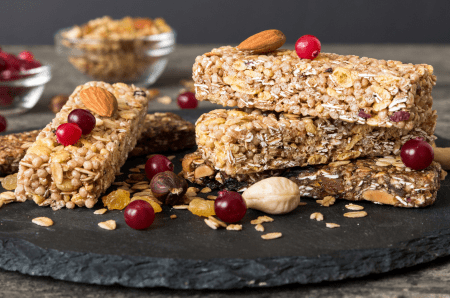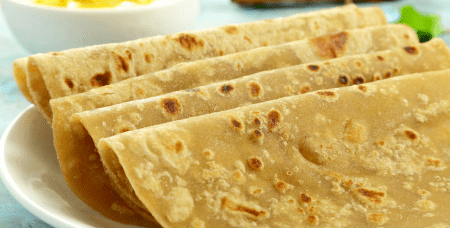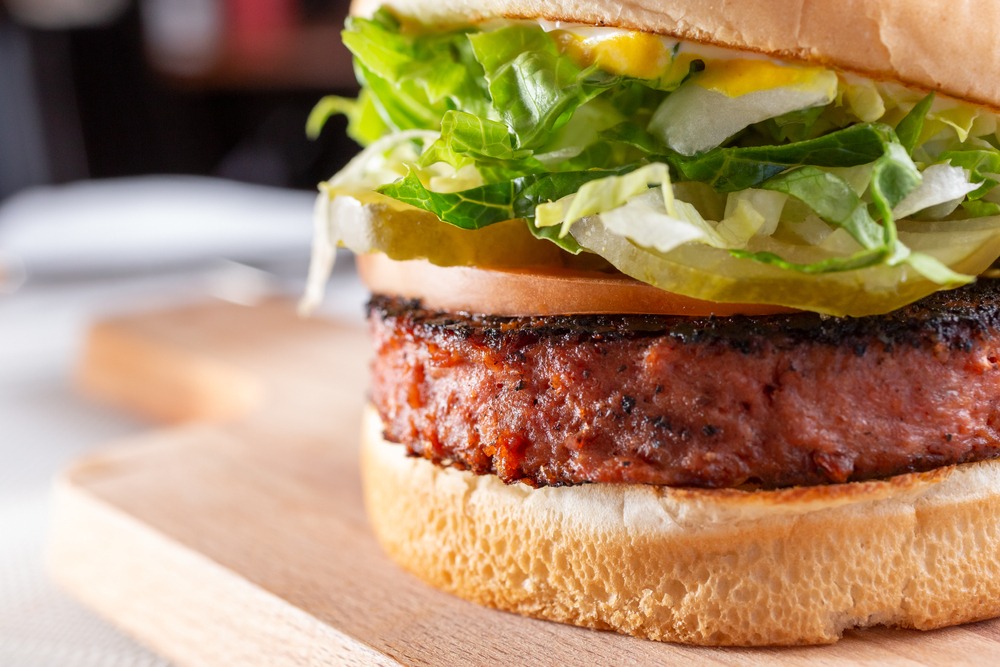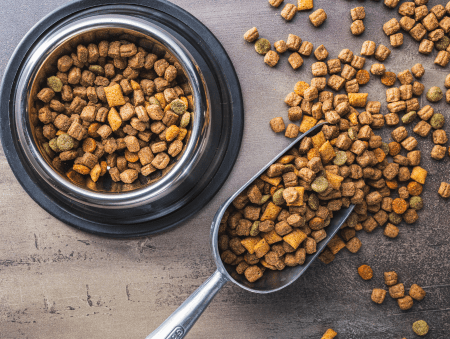Application

Protein Bars and Snacks
The demand for plant-based protein bars has been steadily increasing, driven by various factors related to health, sustainability, and dietary preferences.
Nutritional Properties
The demand for plant-based protein bars has been steadily increasing, driven by various factors related to health, sustainability, and dietary preferences. Nutritional Properties: Pea protein is low in fat and carbohydrates, making it a lean protein source. It's also rich in fiber, which helps promote digestive health and provides a feeling of fullness.
Texture and Taste
Native pea protein has a neutral taste and a smooth texture, making it versatile for use in various food applications. It blends well with other ingredients and can be used to create snacks and bars with appealing flavor profiles.
Functional Properties
Pea protein has excellent emulsifying and binding properties, which make it suitable for use in snack and bar formulations. It helps improve texture, structure, and mouthfeel in finished products.
Flour Fortification/ Gluten Free Flour Protein Atta/ Diabetic Atta
Using native pea protein concentrate and native pea flour to create specialty atta varieties such as gluten-free, protein-rich, weight management, and diabetic-friendly atta is indeed feasible and offers numerous nutritional benefits. Here’s how each type of specialty atta can be formulated using pea protein concentrate and pea flour:


Flour Fortification/ Gluten Free Flour Protein Atta/ Diabetic Atta
Using native pea protein concentrate and native pea flour to create specialty atta varieties such as gluten-free, protein-rich, weight management, and diabetic-friendly atta is indeed feasible and offers numerous nutritional benefits. Here’s how each type of specialty atta can be formulated using pea protein concentrate and pea flour:
Gluten-Free Atta
Pea flour can serve as a gluten-free alternative to traditional wheat flour. Pea flour is naturally gluten-free, making it suitable for individuals with gluten intolerance or celiac disease. Combining pea flour with other gluten-free ingredients like rice flour, sorghum flour, or chickpea flour can create a versatile gluten-free atta blend.
Protein-Rich Atta
Native pea protein concentrate is an excellent source of plant-based protein. By incorporating pea protein concentrate into the atta blend, you can significantly increase its protein content. This protein-rich atta is suitable for individuals looking to boost their protein intake, including vegetarians, vegans, athletes, and those following high-protein diets.
Weight Management Atta
A weight management atta can be formulated by combining pea protein concentrate and pea flour with other nutrient-rich ingredients such as whole grains, seeds, and fiber sources. This atta blend provides satiety and helps regulate blood sugar levels, promoting a feeling of fullness and supporting weight management goals.
Diabetic-Friendly Atta
Pea flour has a low glycemic index, which means it causes a slower and more gradual rise in blood sugar levels compared to refined wheat flour. Formulating a diabetic-friendly atta using pea flour and pea protein concentrate can help individuals with diabetes manage their blood sugar levels more effectively. Additionally, incorporating soluble fiber sources like psyllium husk or flaxseed meal can further enhance the atta's glycemic response.

Bread/Bakery / Cerals
Bread is the most consumed item worldwide , so increasing the nutritional value of bread impacts large on society. Native pea starch can be used to prepare gluten-free bread and other baked goods. Pea starch, derived from yellow peas, is naturally gluten-free and serves as a suitable alternative to wheat flour for individuals with gluten intolerance or celiac disease.
Pea starch contributes to the texture and binding properties of gluten-free bread. It helps improve the crumb structure, moisture retention, and overall mouthfeel of the bread.
Pea protein concentrate can be blended with this to increase the value of protein in bread or other bakery products.
Native pea protein concentrate can be used in cereals to enhance their nutritional profile and provide additional protein content. Cereals are a popular breakfast option for many people, and fortifying them with pea protein concentrate can offer numerous benefits.
Protein Rich Pasta/ Noodles/ Pizza Base
Native pea starch offers several advantages when used in the production of pizza bases, pasta, and noodles, including improved texture, enhanced nutritional value, and suitability for gluten-free applications. By incorporating pea starch into these food products, manufacturers can cater to consumer preferences for healthier and more diverse meal options while capitalizing on the functional and nutritional benefits of this versatile ingredient.


Protein Rich Pasta/ Noodles/ Pizza Base
Native pea starch offers several advantages when used in the production of pizza bases, pasta, and noodles, including improved texture, enhanced nutritional value, and suitability for gluten-free applications. By incorporating pea starch into these food products, manufacturers can cater to consumer preferences for healthier and more diverse meal options while capitalizing on the functional and nutritional benefits of this versatile ingredient.
Pizza Base
Pea starch can be incorporated into pizza dough recipes to enhance the texture and structure of the crust. It helps improve dough elasticity, aiding in the stretching and shaping of the pizza base. Pea starch also contributes to a crispier crust when baked, providing a satisfying texture. Additionally, using pea starch in pizza dough formulations can add a nutritional boost by increasing the fiber content and providing additional vitamins and minerals naturally present in peas. To use pea starch in pizza base recipes, it can be substituted for a portion of the wheat flour or combined with other gluten-free flours to create a dough that is suitable for individuals with gluten intolerance or celiac disease.
Pasta
Pea starch can be incorporated into pasta dough recipes to improve texture, firmness, and cooking properties. It helps create a smooth and elastic dough that can be rolled out and shaped into various pasta shapes, such as spaghetti, penne, or lasagna sheets. Pea starch also contributes to the overall nutritional quality of pasta by increasing its fiber content and protein content, making it a more satisfying and nutritious meal option. When using pea starch in pasta recipes, it can be combined with semolina flour, durum wheat flour, or other gluten-free flours to achieve the desired texture and consistency.
Noodles
Pea starch can be used in the production of noodles to improve their texture, chewiness, and resilience during cooking. It helps create noodles that are firm yet tender and have a smooth surface. Pea starch can also enhance the nutritional value of noodles by increasing their fiber and protein content, making them a more filling and nutritious meal option. In noodle manufacturing, pea starch can be used as a binding agent and texture modifier in the dough formulation, contributing to the desired characteristics of the final product. Noodles made with pea starch can be incorporated into various Asian and Western dishes, such as stir-fries, soups, and salads, providing a versatile and nutritious meal option.

Meat Analogous
Native pea protein is a valuable ingredient in the production of plant-based meat analogue, offering various functional and nutritional benefits. Here’s how native pea protein can be used in plant-based meat analogues
Protein Source
Pea protein serves as a primary protein source in plant-based meat analogues. It contains all nine essential amino acids, making it a complete protein source similar to animal proteins. Pea protein helps provide the texture, structure, and mouthfeel characteristic of meat products.
Texture and Mouthfeel
Native pea protein contributes to the texture and mouthfeel of plant-based meat analogues, giving them a meat-like chewiness and juiciness. It helps create a fibrous and tender texture that mimics the characteristics of animal meat, enhancing the overall eating experience.
Binding Properties
Pea protein has excellent binding properties, allowing plant-based meat analogues to hold their shape during processing and cooking. It helps stabilize the product, preventing it from crumbling or falling apart, and ensures uniformity in texture and appearance.
Allergen-Free and Gluten-Free
Pea protein is naturally free from common allergens such as soy, dairy, nuts, and gluten, making it suitable for individuals with dietary restrictions or food sensitivities. It allows manufacturers to produce plant-based meat analogues that cater to a wider range of consumers.
Pet Foods
Native pea starch is used as a key ingredient in pet food to improve its nutritional value and the texture of the feed.
Pea starch is the can be main source of energy for pets.


Pet Foods
Native pea starch is used as a key ingredient in pet food to improve its nutritional value and the texture of the feed.
Pea starch is the can be main source of energy for pets.
